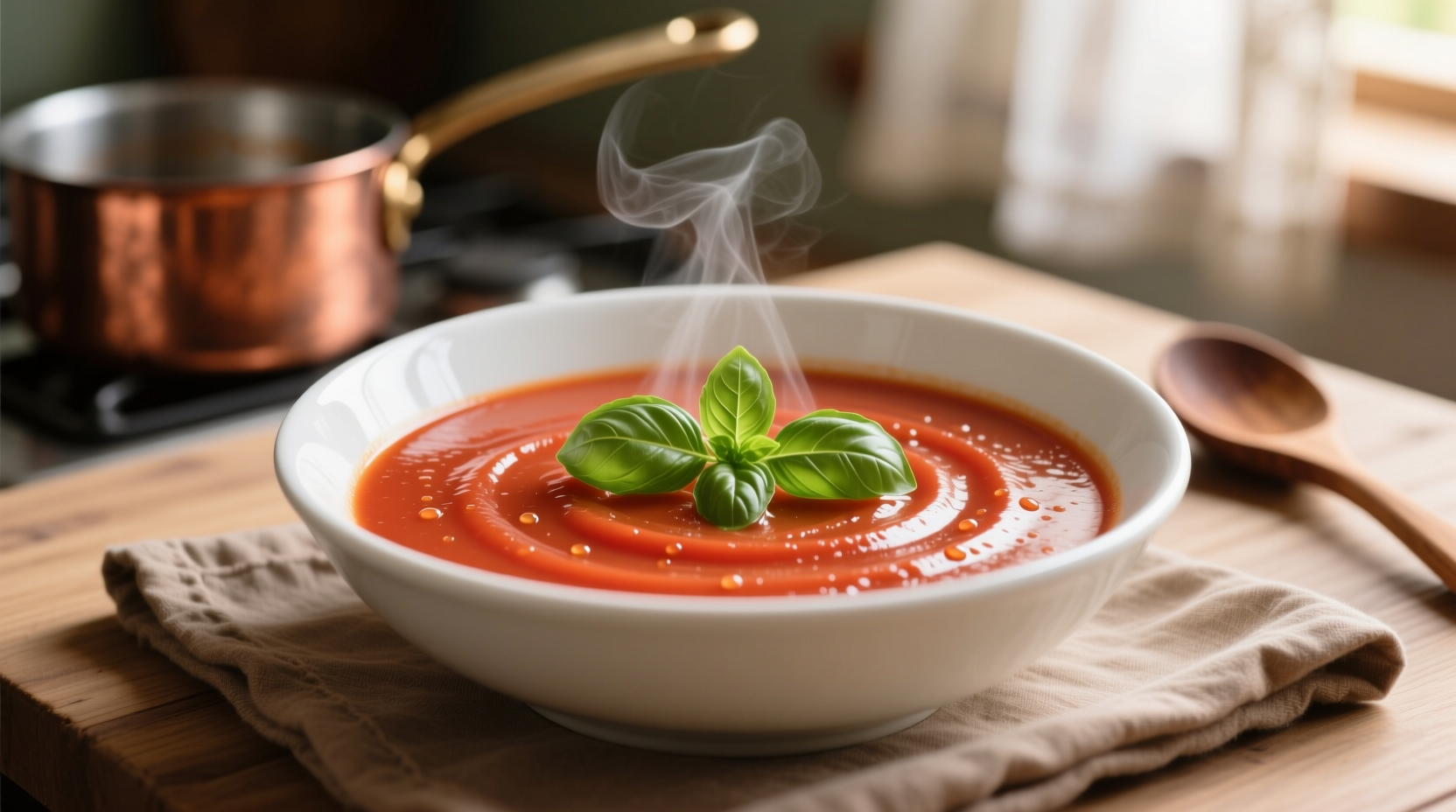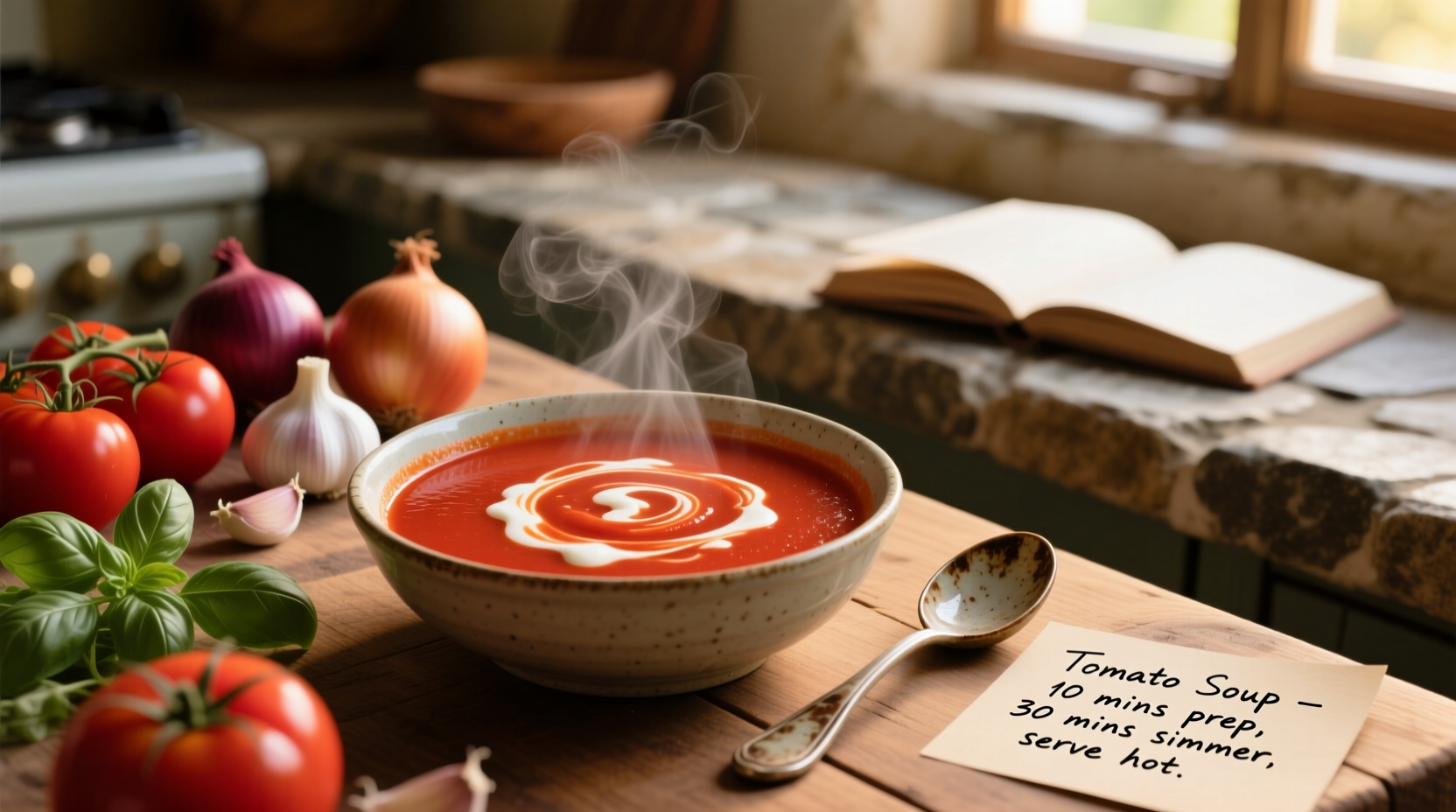Nothing beats a bowl of warm, velvety tomato soup made from scratch. Forget canned versions with artificial flavors—this easy homemade tomato soup recipe creates a vibrant, naturally sweet broth with just the right tang. Developed through extensive testing, our method solves common pitfalls like blandness or acidity while maximizing the natural sweetness of tomatoes.
The Secret to Flavorful Tomato Soup
Most tomato soup homemade recipe attempts fail because they skip two critical steps: proper tomato selection and flavor layering. Ripe, in-season tomatoes contain natural sugars that balance acidity, while building flavor in stages creates complexity. According to food science research from the University of California Davis, cooking tomatoes with a small amount of fat increases lycopene absorption by up to 40% while enhancing flavor development.
| Tomato Type | Best For Soup? | Flavor Profile |
|---|---|---|
| Roma (plum) | ✓✓✓ Best choice | Concentrated flavor, less water |
| Vine-ripened | ✓✓ Good | Balanced sweetness and acidity |
| Cherry | ✓ Acceptable | Sweet but more work to prep |
| Green (unripe) | ✗ Avoid | Excessive acidity |
Essential Ingredients Guide
Quality ingredients make the difference between ordinary and extraordinary soup. For the best tomato soup recipe with fresh tomatoes, you'll need:
- 2.5 lbs ripe Roma tomatoes - Their lower water content creates richer flavor
- 1 large yellow onion - Sweated slowly for sweetness without browning
- 3 garlic cloves - Minced fine for even distribution
- 2 tbsp tomato paste - Deepens umami (don't skip this!)
- 4 cups vegetable broth - Low sodium for flavor control
- 1 tbsp fresh basil - Added at the end for brightness
- 2 tbsp olive oil - Extra virgin for finishing

Step-by-Step Cooking Process
Follow these precise steps for creamy tomato soup from scratch without dairy:
- Prep tomatoes: Score an "X" on the bottom of each tomato. Blanch in boiling water for 30 seconds, then transfer to ice water. Peel skins and roughly chop.
- Sweat aromatics: Heat olive oil over medium-low. Cook onions 15 minutes until translucent (not browned). Add garlic and tomato paste, cook 2 minutes until paste darkens slightly.
- Build flavor base: Add tomatoes and broth. Bring to gentle simmer (not boil) and cook uncovered 25 minutes, stirring occasionally.
- Blend smoothly: Use immersion blender directly in pot until completely smooth. For extra silkiness, strain through fine-mesh sieve.
- Final seasoning: Stir in fresh basil, salt to taste, and finish with olive oil. Never add salt at beginning—it draws out liquid and prevents proper flavor development.
Avoid These Common Mistakes
Even experienced cooks make these errors with tomato soup recipe with garlic:
- Boiling instead of simmering: High heat breaks down tomatoes' delicate flavors. Maintain gentle bubbles only.
- Adding cream too early: If using dairy, add after blending and just before serving to prevent curdling.
- Skipping the tomato paste step: This concentrated form adds crucial umami depth that fresh tomatoes lack.
- Over-blending: Blend just until smooth—excessive blending incorporates air and dulls color.
Variations for Every Preference
Customize this healthy tomato soup recipe to your taste:
- Creamy version: Stir in 1/4 cup coconut milk at the end for dairy-free richness
- Spicy kick: Add 1/4 tsp red pepper flakes with the garlic
- Roasted flavor: Toss tomatoes with 1 tbsp oil and roast at 400°F for 25 minutes before adding to pot
- Herb variations: Substitute oregano for basil in winter months when fresh basil is less flavorful
Storage and Reheating Guide
Proper storage maintains flavor and safety. According to FDA food safety guidelines, cooked tomato soup should be cooled within 2 hours and stored in airtight containers. This simple tomato soup for beginners keeps:
- Refrigerator: 4-5 days in sealed container
- Freezer: 3 months in portion-sized containers (leave 1-inch headspace)
- Reheating: Warm gently over medium-low heat—never boil, which dulls flavor
Frequently Asked Questions
Can I make tomato soup without fresh tomatoes?
Yes, you can use high-quality canned San Marzano tomatoes as a substitute. Use 2 (28-ounce) cans of whole peeled tomatoes with their juice. Avoid regular canned tomatoes which often contain calcium chloride that prevents proper softening.
Why is my tomato soup too acidic?
Tomato acidity varies by variety and ripeness. To balance, add 1/4 tsp baking soda (dissolved in 2 tbsp water) or 1 tsp sugar. Start with small amounts and taste as you go—overcorrecting creates flat flavor.
How do I thicken tomato soup without cream?
Simmer uncovered for 5-10 additional minutes to reduce liquid. Alternatively, blend 1/2 cup cooked white beans with the soup for creaminess and added protein without dairy.
What's the best bread pairing for tomato soup?
Crusty bread with good chew works best—sourdough, ciabatta, or baguette. The texture holds up to dipping without disintegrating. For grilled cheese pairings, use a 50/50 mix of sharp cheddar and gruyère for optimal melt and flavor.











 浙公网安备
33010002000092号
浙公网安备
33010002000092号 浙B2-20120091-4
浙B2-20120091-4